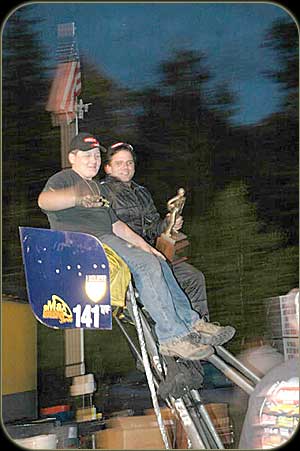Words and photos by Jeff Burk Few races in the International Hot Rod Association’s long history will match the drama, and historic performances that were witnessed by the fans and racers that filled the legendary New England Dragway in Epping, New Hampshire, on the weekend of that track’s 40th anniversary.
Not historic enough? Then how about the quickest and fastest gasoline/carbureted pass in history? Robert Patrick stunned everyone on the premises with a final round 6.315/221 defeat of Rob Mansfield that not only garnered the Ford racer both ends of the National Record but also the Championship. Want some more historic performances? Then consider the performance of Bob Gilbertson, his crew and their Dodge Stratus fuel coupe. Bob needed to “run the table” to get enough points to have any chance of winning the IHRA Championship. He did just that by re-setting the National ET record on his way to winning the race. Yes sir, any way you look at the 2006 IHRA Northern Nationals either from a record performances perspective or from a historic event perspective, it has to rank as one of the great IHRA races of past couple of decades or more. TOP FUEL Probably due to the fact that many of the IHRA’s semi-regulars -- limited budget racers such as T.J. Zizzo, Andrew Cowin and Jack Ostrander -- either raced the previous weekend or just didn’t come, the Top Fuel field was limited to just seven cars, but three of those had either won races this year or were the defending series champion. This was an instance where quality replaced quantity. The wild card for the racers was the atmospheric conditions. That word is generally overused when talking about race performance but sub-70-degree air temps combined with high barometric pressure and water grain counts below 50 made for conditions that more than one crew chief compared to “Chicago in October.” |

 You want historic? How about 74-year-old racer Chris Karamesines and tuner Tim Finley putting their Strange Engineering-backed Top Fueler into a historic final round match-up with second generation racer Bobby Lagana Jr. Although the field was one car short, it was not weak with national event winners and World Champions such as Clay Millican, Bruce Litton, Doug Foley and Lagana in the field.
You want historic? How about 74-year-old racer Chris Karamesines and tuner Tim Finley putting their Strange Engineering-backed Top Fueler into a historic final round match-up with second generation racer Bobby Lagana Jr. Although the field was one car short, it was not weak with national event winners and World Champions such as Clay Millican, Bruce Litton, Doug Foley and Lagana in the field.